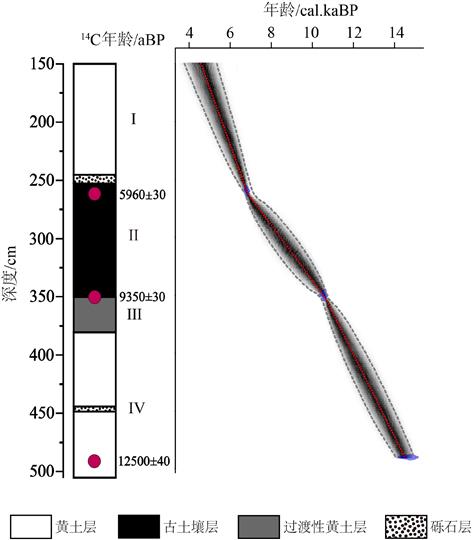| 临汾盆地晚冰期至中全新世黄土-古土壤序列的风化特征及指示的气候意义 |
| |
| 引用本文: | 石天宇, 张样洋, 翟秋敏, 李洪彬, 刘畅, 周学文, 陈鹏, 陈亮. 临汾盆地晚冰期至中全新世黄土-古土壤序列的风化特征及指示的气候意义[J]. 海洋地质与第四纪地质, 2023, 43(2): 181-191. doi: 10.16562/j.cnki.0256-1492.2022070501 |
| |
| 作者姓名: | 石天宇 张样洋 翟秋敏 李洪彬 刘畅 周学文 陈鹏 陈亮 |
| |
| 作者单位: | 1.河南大学地理与环境学院,开封 475004;; 2.河南省地球系统观测与模拟重点实验室,开封 475004 |
| |
| 基金项目: | 国家重点研发项目“中华文明探源研究”子课题“中华文明起源进程中的古环境和人地关系研究”(2020YFC1521605);;国家自然科学基金“近2万年来豫西黄土堆积揭示的植被演替、气候变化与古人类活动”(41701231); |
| |
| 摘 要: | 
了解中国北方晚冰期和全新世时期的气候环境变化及其驱动机制,有助于预测未来气候变化的可能情景。基于黄土高原东南缘临汾盆地的黄土-古土壤剖面,在3个AMS14C年代的支持下,通过粒度、磁化率、土壤有机碳以及地球化学元素等指标,重建了临汾盆地晚冰期至中全新世晚期的气候变化历史。
结果表明:宋村沟剖面的黄土和古土壤分别处于初等和中等化学风化阶段,而不同地区风成堆积物的化学风化强度存在明显差异,主要受控于东亚夏季风的区域变化。多指标综合分析表明,晚冰期以来临汾盆地的气候演变经历了4个阶段:晚冰期东亚冬季风较强,气候干冷;早全新世东亚夏季风强化,气候向暖湿转变;早中全新世东亚夏季风达到峰值,为最暖湿的适宜期;中全新世晚期东亚夏季风减弱,气候再次转向干冷;临汾盆地的气候变化主要受控于北半球太阳辐射强度和冰量的变化。

|
| 关 键 词: | 黄土 晚冰期 全新世 东亚季风 气候变化 |
| 收稿时间: | 2022-07-05 |
| 修稿时间: | 2022-08-18 |
|
| 点击此处可从《海洋地质与第四纪地质》浏览原始摘要信息 |
|
点击此处可从《海洋地质与第四纪地质》下载全文 |
|



